
Blog:
When and why should I use
flagstone in landscaping?
Flagstone is probably the most commonly used natural stone for hardscaping surfaces in landscaping projects. Hardscaping includes the permanent elements of your landscape. Flagstone is often selected for its aesthetic appeal and natural rock appearance to create a rustic, outdoors look. They are often used on patio or walkway surfaces, as surfaces for planters, facing for walls. Bancos or benches can also benefit from a flagstone surface, which is easily sanded down to create smooth edges that won’t snag clothes like stucco. You can also place individual flagstones in your landscaping as stepping stones, creating an inviting natural pathway with minimal effort and easy maintenance. Flagstone is often less expensive than other types of natural stone used in landscaping because it is soft, easily quarried, split, and sized.Flagstone Colors, size, thickness
A wide range of colors is available, depending on where the flagstone is obtained. Flagstone is sandstone -- the binder between the grains of sand often contributes to the color of the rock. Because flagstone splits flat, it is easy to quarry and produce relatively flat slabs. With all the colors available, there are bound to be those you’ll like which can blend into your overall landscape design. Colors include buff, peach, beige, brown, blue, grey, and gold. Color is the primary variance in flagstone; however, size (area of stone and thickness) can also be important. Most flagstone should be about two inches thick if it will hold any weight such as on a walkway or patio. Consider using larger pieces in your installation for a better look. Using all small pieces, for instance, about one foot square, looks more like tile. Of course even with large pieces you’ll have to use a number of small pieces to fill in small areas between large pieces.Where not to use flagstone
Flagstone is not highly durable. Some flaking can occur. You don’t want to use it to hold heavy weight, such as use on a driveway. Sandstone is more likely to crack under heavy loads. Because of these attributes, sandstone use is avoided on driveways and lawn borders where it is more likely to have damage from weight or impact.Flagstone installation
Flagstone is usually installed with two different techniques. In both of these, it is suggested to have a space in-between stones no wider than 2 inches, but often less of a gap. The first installation approach is via installation in a bed of concrete. Once a bed of concrete is in place, flagstone blocks are put in place. This approach provides more support for the stone so it is less likely to crack or break in the future. Grout of various colors can be used to complement the installation and match your design intent. This installation is solid but harder to repair because concrete must be broken out and replaced. A second installation approach is to lay down a bed of packed crusher-fine as a solid surface for the flagstone. Once in place, additional crusher-fine is poured between the stones to lock them into place. You would not want to use grout in this installation as it would eventually break and crack from slight movement of the stones over time. This installation is fairly easy to repair because single flagstones can be removed and replaced.Compare other options with flagstone
Before you decide upon flagsgone, consider the other options available. You typically have five choices for surfaces that you may walk or drive upon. Compare them to help decide which options are best for you. The table represents some, but not all aspects of each type of surface in the table. If you have questions, call Rising Sun Landscaping & Maintenance to review and explain the best options for your landscape project.Traditional options for driveway and walkway surfaces
Materials listed below can be used for many purposes. In this table we suggest how they may be useful only as surfaces in such applications as driveways, walkways, and patios. “Natural Stone” category below, including flagstone, has a wide variety of options that are difficult to capture in one table. For instance, flagstone may work well on a walkway or patio but be inappropriate for a driveway because it typically cannot bear the weight of vehicles without cracking. On the other hand, cobblestone has features similar to pavers, but are often more expensive.
Rio Rancho • Albuquerque • West Mesa • Corrales • Taylor Ranch • East Mountains • Bernallilo • Algodones • Placitas • Cedar Crest • Tijeras • Los Lunas • Belen • Santa Fe
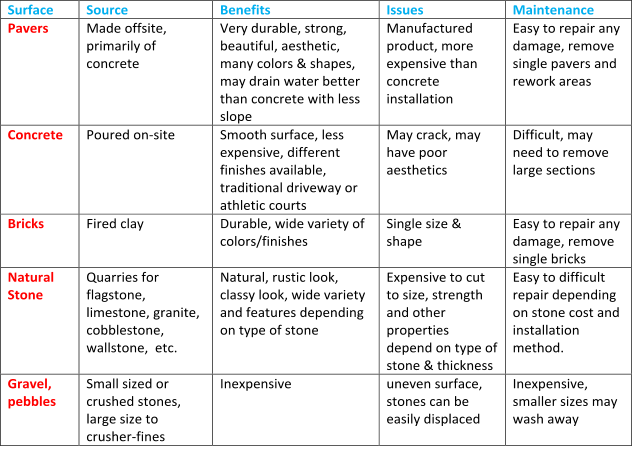

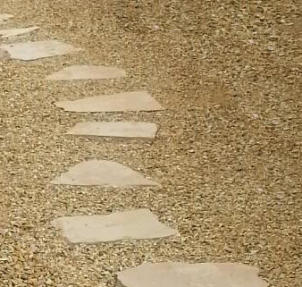
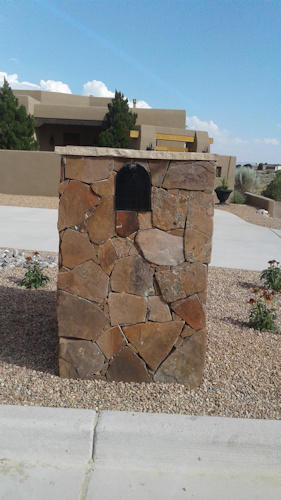
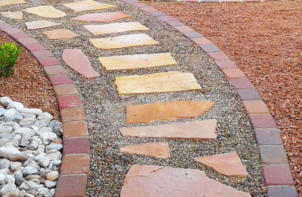
Available everyday 7 am to 8 pm
How can we help you?

- Landscaping Overvew
- Patios, Decks, Gathering Spaces
- Paver Driveways & Sidewalks
- Concrete Driveway Walkway
- Block Walls, Retaining Walls
- Shade, Pergolas, Gazebos
- Water, Ponds, Fountains
- Kitchens, Kivas, Fireplaces, Pits
- Sod, Grass, Lawn Installation
- Synthetic Lawn, Artifical Grass
- Putting Greens
- Irrigation, Sprinklers
- Mailbox address marker planters
- Xeriscape, Xeriscaping


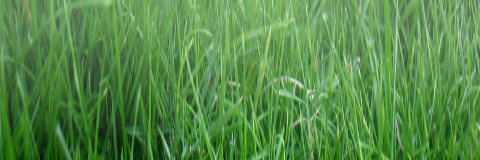
Blog:
When and why should I
use flagstone in
landscaping?
Flagstone is probably the most commonly used natural stone for hardscaping surfaces in landscaping projects. Hardscaping includes the permanent elements of your landscape. Flagstone is often selected for its aesthetic appeal and natural rock appearance to create a rustic, outdoors look. They are often used on patio or walkway surfaces, as surfaces for planters, facing for walls. Bancos or benches can also benefit from a flagstone surface, which is easily sanded down to create smooth edges that won’t snag clothes like stucco. You can also place individual flagstones in your landscaping as stepping stones, creating an inviting natural pathway with minimal effort and easy maintenance. Flagstone is often less expensive than other types of natural stone used in landscaping because it is soft, easily quarried, split, and sized.Flagstone Colors, size, thickness
A wide range of colors is available, depending on where the flagstone is obtained. Flagstone is sandstone -- the binder between the grains of sand often contributes to the color of the rock. Because flagstone splits flat, it is easy to quarry and produce relatively flat slabs. With all the colors available, there are bound to be those you’ll like which can blend into your overall landscape design. Colors include buff, peach, beige, brown, blue, grey, and gold. Color is the primary variance in flagstone; however, size (area of stone and thickness) can also be important. Most flagstone should be about two inches thick if it will hold any weight such as on a walkway or patio. Consider using larger pieces in your installation for a better look. Using all small pieces, for instance, about one foot square, looks more like tile. Of course even with large pieces you’ll have to use a number of small pieces to fill in small areas between large pieces.Where not to use flagstone
Flagstone is not highly durable. Some flaking can occur. You don’t want to use it to hold heavy weight, such as use on a driveway. Sandstone is more likely to crack under heavy loads. Because of these attributes, sandstone use is avoided on driveways and lawn borders where it is more likely to have damage from weight or impact.Flagstone installation
Flagstone is usually installed with two different techniques. In both of these, it is suggested to have a space in- between stones no wider than 2 inches, but often less of a gap. The first installation approach is via installation in a bed of concrete. Once a bed of concrete is in place, flagstone blocks are put in place. This approach provides more support for the stone so it is less likely to crack or break in the future. Grout of various colors can be used to complement the installation and match your design intent. This installation is solid but harder to repair because concrete must be broken out and replaced. A second installation approach is to lay down a bed of packed crusher-fine as a solid surface for the flagstone. Once in place, additional crusher-fine is poured between the stones to lock them into place. You would not want to use grout in this installation as it would eventually break and crack from slight movement of the stones over time. This installation is fairly easy to repair because single flagstones can be removed and replaced.Compare other options with flagstone
Before you decide upon flagsgone, consider the other options available. You typically have five choices for surfaces that you may walk or drive upon. Compare them to help decide which options are best for you. The table represents some, but not all aspects of each type of surface in the table. If you have questions, call Rising Sun Landscaping & Maintenance to review and explain the best options for your landscape project.Traditional options for driveway and
walkway surfaces
Materials listed below can be used for many purposes. In this table we suggest how they may be useful only as surfaces in such applications as driveways, walkways, and patios. “Natural Stone” category below, including flagstone, has a wide variety of options that are difficult to capture in one table. For instance, flagstone may work well on a walkway or patio but be inappropriate for a driveway because it typically cannot bear the weight of vehicles without cracking. On the other hand, cobblestone has features similar to pavers, but are often more expensive.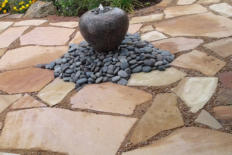
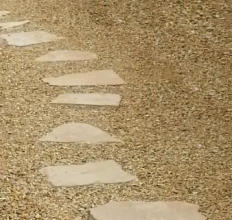

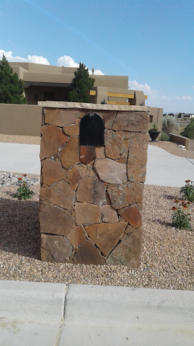
Rio Rancho • Albuquerque • West Mesa • Corrales • Taylor Ranch • East Mountains
Bernallilo • Algodones • Placitas • Cedar Crest • Tijeras • Los Lunas • Belen • Santa Fe
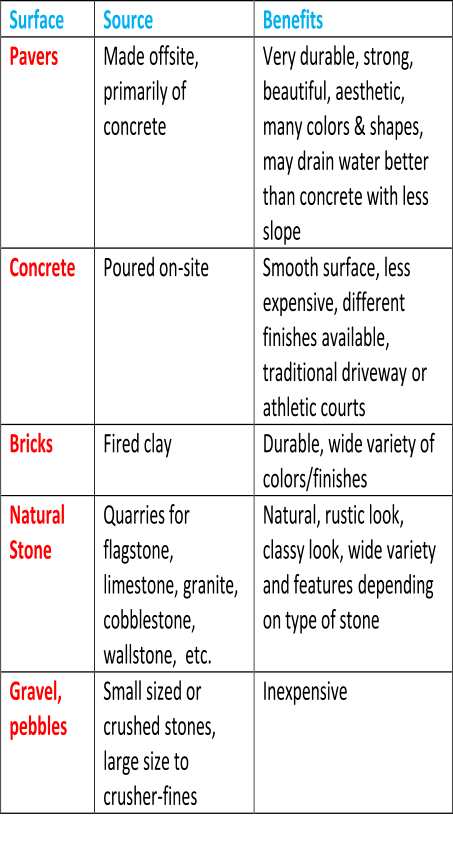
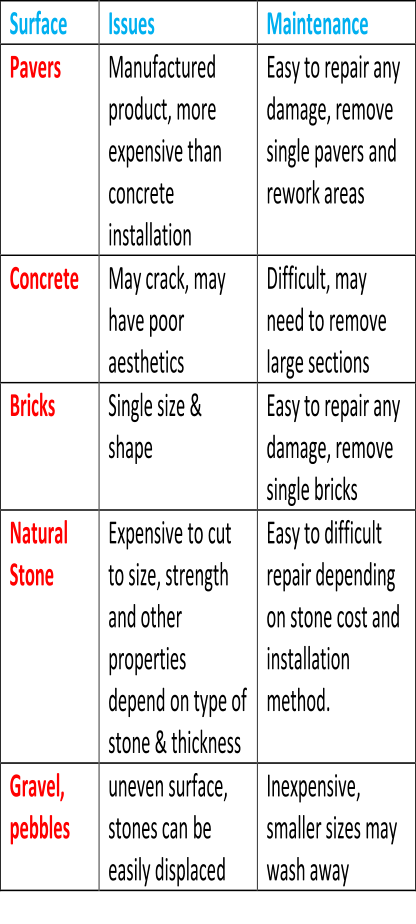



- Home
- Landscaping
- Landscaping Overiew
- Concrete Driveway Walkway
- Block Walls, Retaining Walls
- Shade, Pergolas, Gazebos
- Water, Ponds, Fountains
- Kitchens, Kivas, Fireplaces, Pits
- Sod, Grass, Lawn Installation
- Synthetic Lawn, Artificial Turf
- Putting Greens
- Patios, Decks, Gathering Spaces
- Irrigation, Sprinklers
- Mailbox address marker planters
- Xeriscape, Xeriscaping
- Paver Driveways & Sidewalks
- Commercial Landscaping
- Maintenance
- Landscape Gallery
- About
- Blog






























